-
Product Name
Cytokeratin 18 antibody
- Documents
-
Description
Cytokeratin 18 Rabbit Polyclonal antibody. Positive IF detected in HeLa cells, HepG2 cells, mouse olfactory epithelium tissue. Positive IHC detected in human breast cancer tissue, human cervical cancer tissue, human colon cancer tissue, human endometrial cancer tissue, human liver cancer tissue, human lung cancer tissue, human ovary tumor tissue, human pancreas cancer tissue, human prostate cancer tissue, human stomach cancer tissue. Positive FC detected in MCF-7 cells. Positive WB detected in A431 cells, K-562 cells. Positive IP detected in A431 cells. Observed molecular weight by Western-blot: 48 kDa
-
Tested applications
ELISA, WB, IP, IF, FC, IHC
-
Species reactivity
Human, Mouse; other species not tested.
-
Alternative names
CK 18 antibody; CYK18 antibody; Cytokeratin 18 antibody; K18 antibody; keratin 18 antibody; KRT18 antibody
- Immunogen
-
Isotype
Rabbit IgG
-
Preparation
This antibody was obtained by immunization of Cytokeratin 18 recombinant protein (Accession Number: NM_000224). Purification method: Antigen affinity purified.
-
Clonality
Polyclonal
-
Formulation
PBS with 0.1% sodium azide and 50% glycerol pH 7.3.
-
Storage instructions
Store at -20℃. DO NOT ALIQUOT
-
Applications
Recommended Dilution:
WB: 1:1000-1:10000
IP: 1:1000-1:10000
IHC: 1:50-1:500
IF: 1:20-1:200
-
Validations
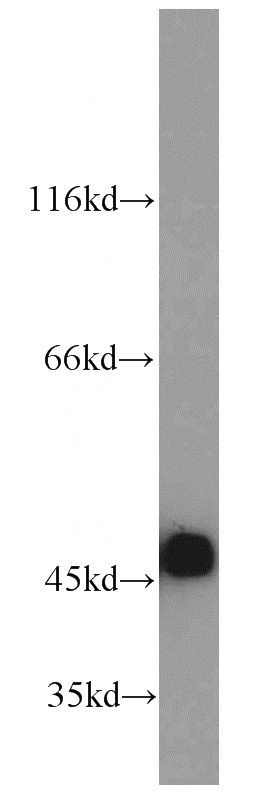
A431 cells were subjected to SDS PAGE followed by western blot with Catalog No:109800(KRT18 antibody) at dilution of 1:2000
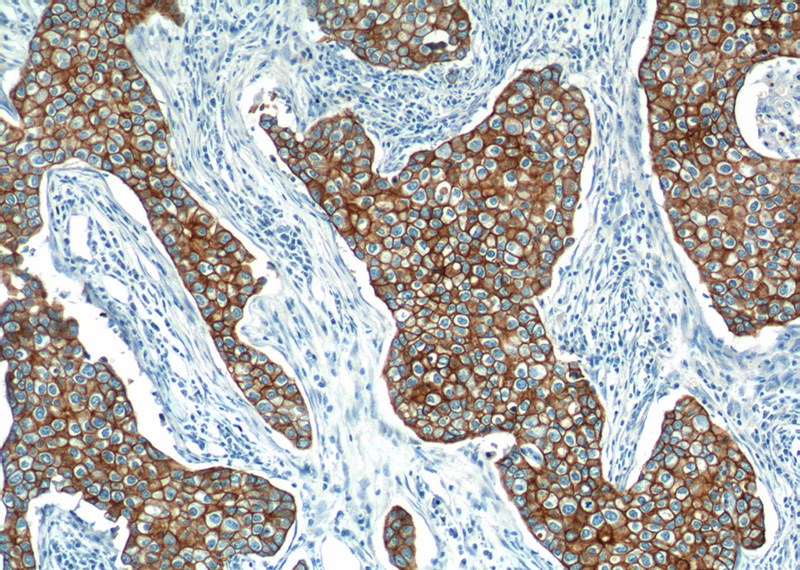
Immunohistochemistry of paraffin-embedded human breast cancer tissue slide using Catalog No:109800(KRT18 Antibody) at dilution of 1:1000 (under 10x lens).
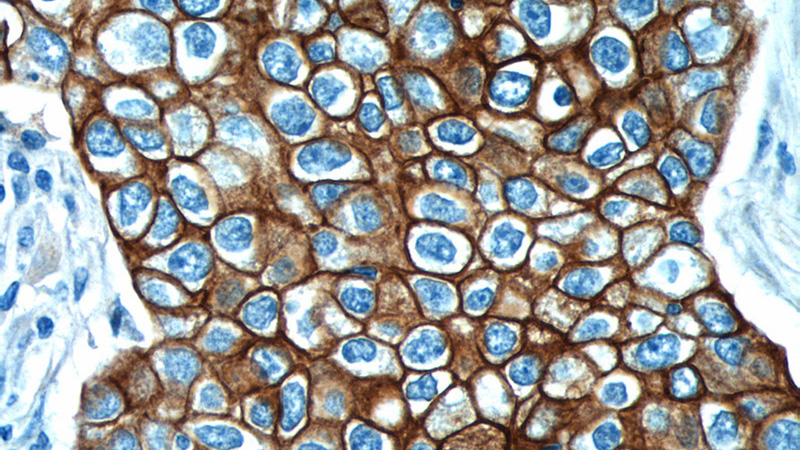
Immunohistochemistry of paraffin-embedded human breast cancer tissue slide using Catalog No:109800(KRT18 Antibody) at dilution of 1:1000 (under 40x lens).
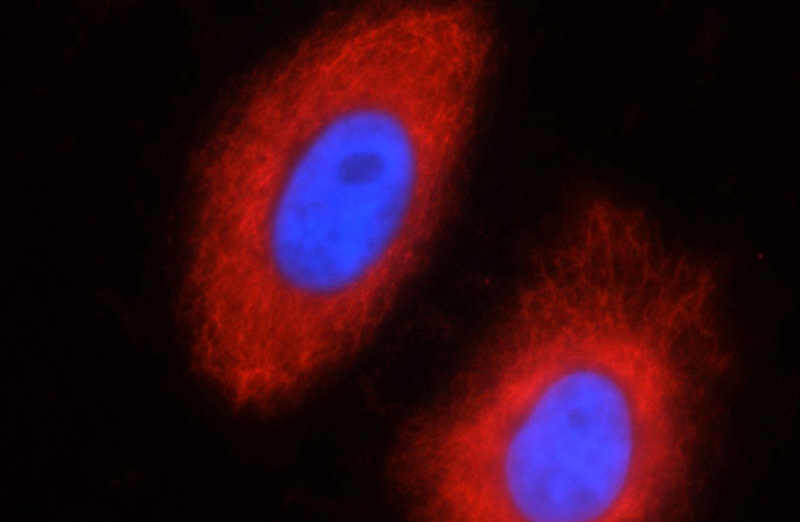
Immunofluorescent analysis of HeLa cells using Catalog No:109800(KRT18 Antibody) at dilution of 1:50 and Rhodamine-Goat anti-Rabbit IgG
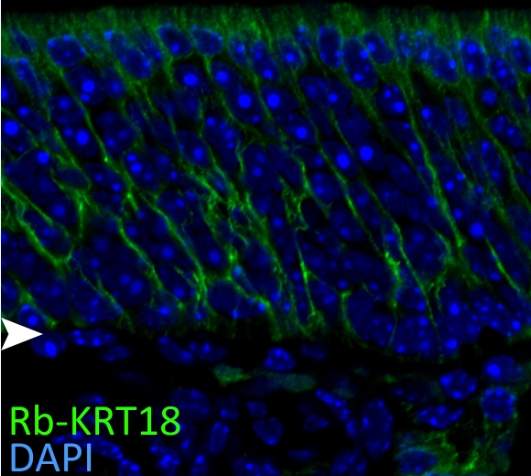
IF result of CK18 antibody (Catalog No:109800, 1:50) with 1% PLP fixed the apical sustentacular cells of adult mouse olfactory epithelium. (Green: CK18; Blue: DAPI). Basal lamina is marked by an arrow head. By Brian Lin, Tufts University.
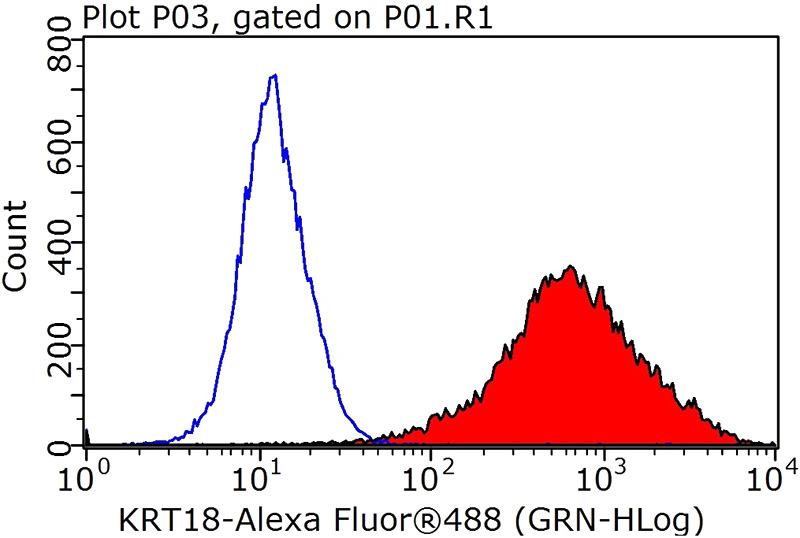
1X10^6 MCF-7 cells were stained with 0.2ug KRT18 antibody (Catalog No:109800, red) and control antibody (blue). Fixed with 90% MeOH blocked with 3% BSA (30 min). Alexa Fluor 488-congugated AffiniPure Goat Anti-Rabbit IgG(H+L) with dilution 1:1000.
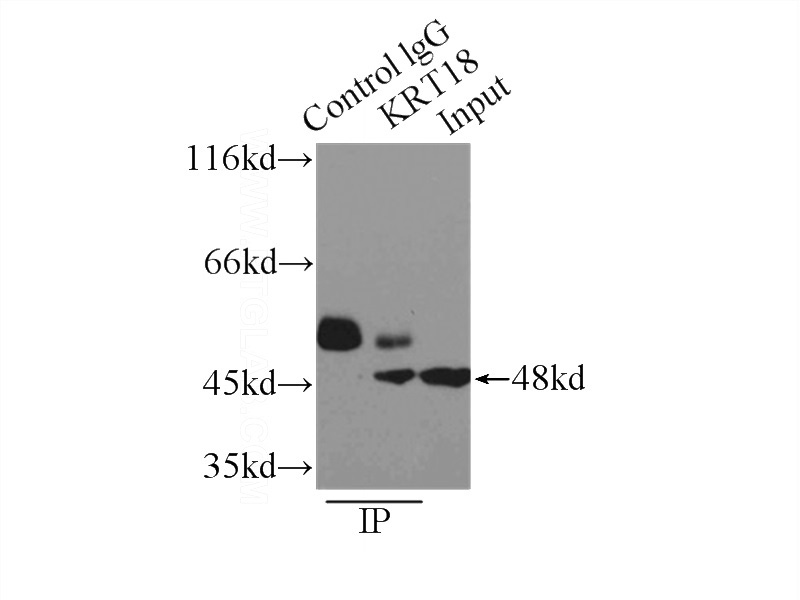
IP Result of anti-KRT18 (IP:Catalog No:109800, 3ug; Detection:Catalog No:109800 1:2000) with A431 cells lysate 3300ug.
-
Background
Keratins are a large family of proteins that form the intermediate filament cytoskeleton of epithelial cells, which are classified into two major sequence types. Type I keratins are a group of acidic intermediate filament proteins, including K9–K23, and the hair keratins Ha1–Ha8. Type II keratins are the basic or neutral courterparts to the acidic type I keratins, including K1–K8, and the hair keratins, Hb1–Hb6. KRT18, also named as CYK18, PIG46 and K18, is the most commonly found members of the intermediate filament gene family. KRT18 is a type I keratin which is found primarily in non squamous epithelia and is present in a majority of adenocarcinomas and ductal carcinomas but not in squamous cell carcinomas.
-
References
- Wada-Hiraike O, Hiraike H, Okinaga H. Role of estrogen receptor beta in uterine stroma and epithelium: Insights from estrogen receptor beta-/- mice. Proceedings of the National Academy of Sciences of the United States of America. 103(48):18350-5. 2006.
- Ose R, Yanagawa T, Ikeda S, Ohara O, Koga H. PCDH24-induced contact inhibition involves downregulation of beta-catenin signaling. Molecular oncology. 3(1):54-66. 2009.
- Lawson DA, Zong Y, Memarzadeh S, Xin L, Huang J, Witte ON. Basal epithelial stem cells are efficient targets for prostate cancer initiation. Proceedings of the National Academy of Sciences of the United States of America. 107(6):2610-5. 2010.
- Zhang D, Chen C, Li Y. Cx31.1 acts as a tumour suppressor in non-small cell lung cancer (NSCLC) cell lines through inhibition of cell proliferation and metastasis. Journal of cellular and molecular medicine. 16(5):1047-59. 2012.
- Strand DW, Jiang M, Murphy TA. PPARγ isoforms differentially regulate metabolic networks to mediate mouse prostatic epithelial differentiation. Cell death & disease. 3:e361. 2012.
- Zhao X, Cong X, Zheng L, Xu L, Yin L, Peng J. Dioscin, a natural steroid saponin, shows remarkable protective effect against acetaminophen-induced liver damage in vitro and in vivo. Toxicology letters. 214(1):69-80. 2012.
- Chen Y, Wang K, Leach R. 5-Aza-dC treatment induces mesenchymal-to-epithelial transition in 1st trimester trophoblast cell line HTR8/SVneo. Biochemical and biophysical research communications. 432(1):116-22. 2013.
- Perez-Pinera P, García-Suarez O, Germanà A. Characterization of sensory deficits in TrkB knockout mice. Neuroscience letters. 433(1):43-7. 2008.
Related Products / Services
Please note: All products are "FOR RESEARCH USE ONLY AND ARE NOT INTENDED FOR DIAGNOSTIC OR THERAPEUTIC USE"
